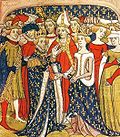

A surcoat or surcote is an outer garment that was commonly worn by soldiers in the Middle Ages. It was worn over armor to show insignia and help identify what side the soldier was on. On the battlefield, the surcoat helped keep the sun off the soldier and their armor, reducing the risk of heat illness. The name derives from French, meaning "over the coat", a long, loose, often sleeveless coat reaching down to the feet. [1]





